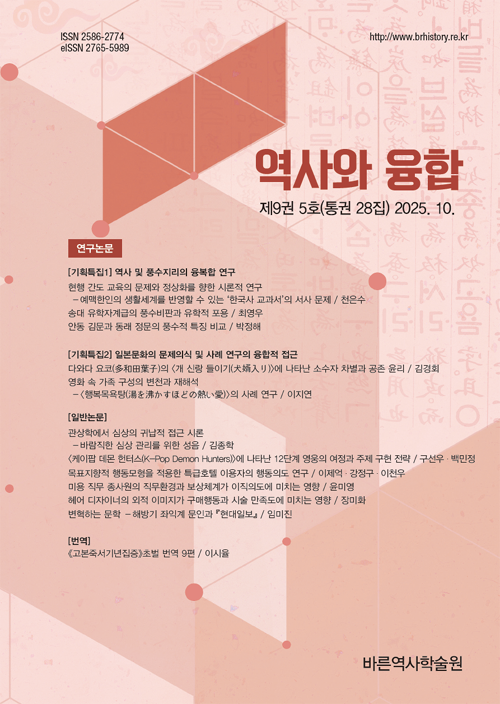- 영문명
- An Exploratory Study on the Inductive Approach to Simsang in Physiognomy : Seong-eum for Desirable Simsang Management
- 발행기관
- 바른역사학술원
- 저자명
- 김종학(Jonghak Kim)
- 간행물 정보
- 『역사와 융합』제28호, 189~222쪽, 전체 34쪽
- 주제분류
- 인문학 > 기타인문학
- 파일형태
- 발행일자
- 2025.10.30

국문 초록
관상학은 심상을 통해 외부로 드러나는 대상자의 용모와 자태를 포함한 체상과 기색, 성음을 살펴 그 사람의 품성과 성향, 건강과 수명 등 길흉화복귀천의 흐름을 현재의 관점에서 파악하고 예측하는 학문으로 정의되고, 관상의목적을 달성하기 위해 체상을 통하여 심상의 완급과 과부족 등 자기수양의경과를 점검할 수 있으며, 다시 심상을 통하여 체상과의 조화와 균형을 관리함으로써 심신의 상이 상생할 수 있는 근본이 되도록 하는 것이 관상의 목적달성을 위한 중요한 수단이자 목표가 된다. 심상이 최상격(最上格)으로서 연역적으로 관상학의 모든 분석체계와 유기적이고 정체적(整體的)인 관계를 형성하였다면, 표상으로 드러나는 하나의 상만으로도 귀납적인 심상의 평가와관리가 가능할 수 있어야 한다. 심상을 향한 이러한 귀납적 접근 방식은 ‘모든 상은 심상의 반영’이라는 대명제를 실현시켜 증명하는 확증적 의미를 갖고, 형이상학적이고 비가시적인 심상의 관리가 감각화 될 수 있게 한다.
심상을 향한 귀납적 접근방식의 활용대상에는 여러 가지가 있을 수 있지만, 본고에서는 성음을 제시하였다. 성음에는 심상뿐만 아니라 신체적 특성, 심리상태와 정서, 건강여부 등의 정보가 풍부하게 내포되어 있기 때문인데, 호기의 지속성, 성량, 음질, 음조, 음율, 발음의 정확도, 논리적인 발화, 다변과 과묵, 발화의 조울성 등을 통하여 관련 장부의 영향을 분석할 수 있을 뿐아니라, 일상 속에서 심상이 노출되고 있어 직접적이고, 녹음 등의 방법을 통해 스스로 매 순간 확인할 수 있는 활용의 용이성을 갖기 때문이다. 성음이단순한 소리 이상의 의미를 지녀 현재 정서와 심상의 향방까지 가늠할 수 있는 척도로 볼 수 있는 것이다. 그러므로 성음의 실천적 관리를 통해 관상학의궁극적 목표에 도달하는 심상의 관리가 귀납적으로 이루어 질 수 있을 것으로 보는 것이다.
영문 초록
Physiognomy is defined as a discipline that examines the client’s physical form — including facial appearance and posture — as well as their complexion(기색氣色), and voice tone (성음聲音; seong-eum), which are outwardly revealed through mental images (심상心相; simsang), in order to understand and predict the flow of one’s character and tendencies, health and lifespan, and fortunes or misfortunes from the present perspective.
In order to achieve the purpose of physiognomy, one can examine the course of self-cultivation through the physical form (체상體相; chesang), by assessing the urgency, excess, or deficiency of the mental image (심상心相; simsang), and conversely, by managing the harmony and balance between the physical form and the mental image through simsang, it becomes a fundamental means to enable the mutual enhancement of body and mind, and this becomes both an important method and goal for accomplishing the purpose of physiognomy.
If simsang, as the highest structure, forms a deductive, systematic, and organic relationship with the entire analytic system of physiognomy, then even a single outwardly revealed image (표상表象; pyosang) should enable an inductive evaluation and management of simsang.
This kind of inductive approach toward simsang has a confirmatory meaning, in that it realizes and proves the major premise that “all images are reflections of simsang,” and allows for the metaphysical and invisible management of simsang to become sensibly perceptible.
There can be various subjects for applying this inductive approach to simsang, but this paper presents voice (성음聲音) as an example. This is because voice contains abundant information not only about simsang but also about physical characteristics, psychological state and emotions, and health conditions.
Through aspects such as breath sustainability, vocal volume, tone quality, pitch, rhythm, accuracy of pronunciation, logical speech, talkativeness or silence, and manic - depressive tendencies in speech, one can analyze the influence of related internal organs. Also, since simsang is exposed in everyday life through voice, and it is possible to directly and repeatedly observe it through recordings and other methods, it has practical usability.
Thus, voice is more than just sound — it can be seen as a measure that even reflects the current emotional state and the direction of simsang. Therefore, it is believed that managing simsang, which is the ultimate goal of physiognomy, can be inductively achieved through the practical management of voice.
목차
1. 머리말
2. 관상의 유래와 최상격 심상
3. 성음을 통한 심상의 귀납적 접근
4. 맺음말
참고문헌
키워드
해당간행물 수록 논문
참고문헌
최근 이용한 논문
교보eBook 첫 방문을 환영 합니다!

신규가입 혜택 지급이 완료 되었습니다.
바로 사용 가능한 교보e캐시 1,000원 (유효기간 7일)
지금 바로 교보eBook의 다양한 콘텐츠를 이용해 보세요!


